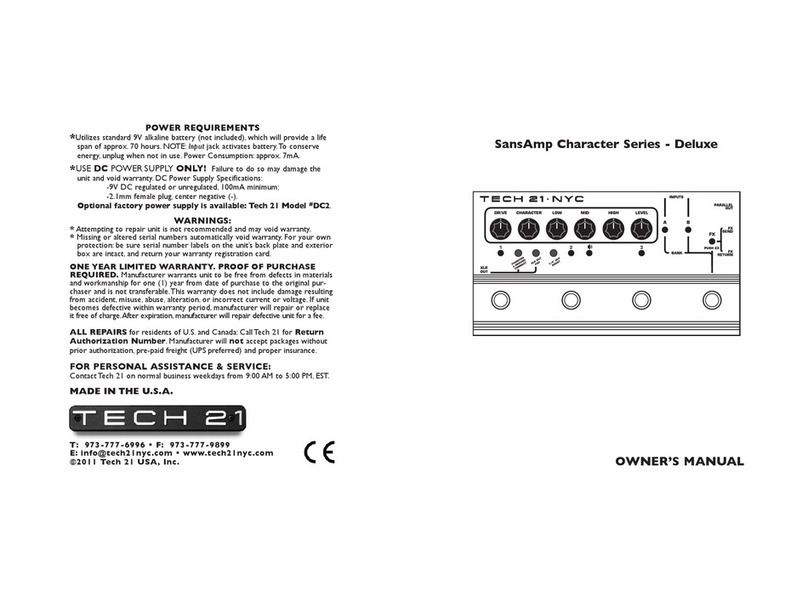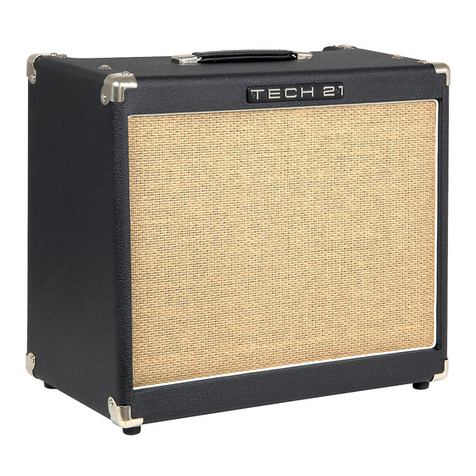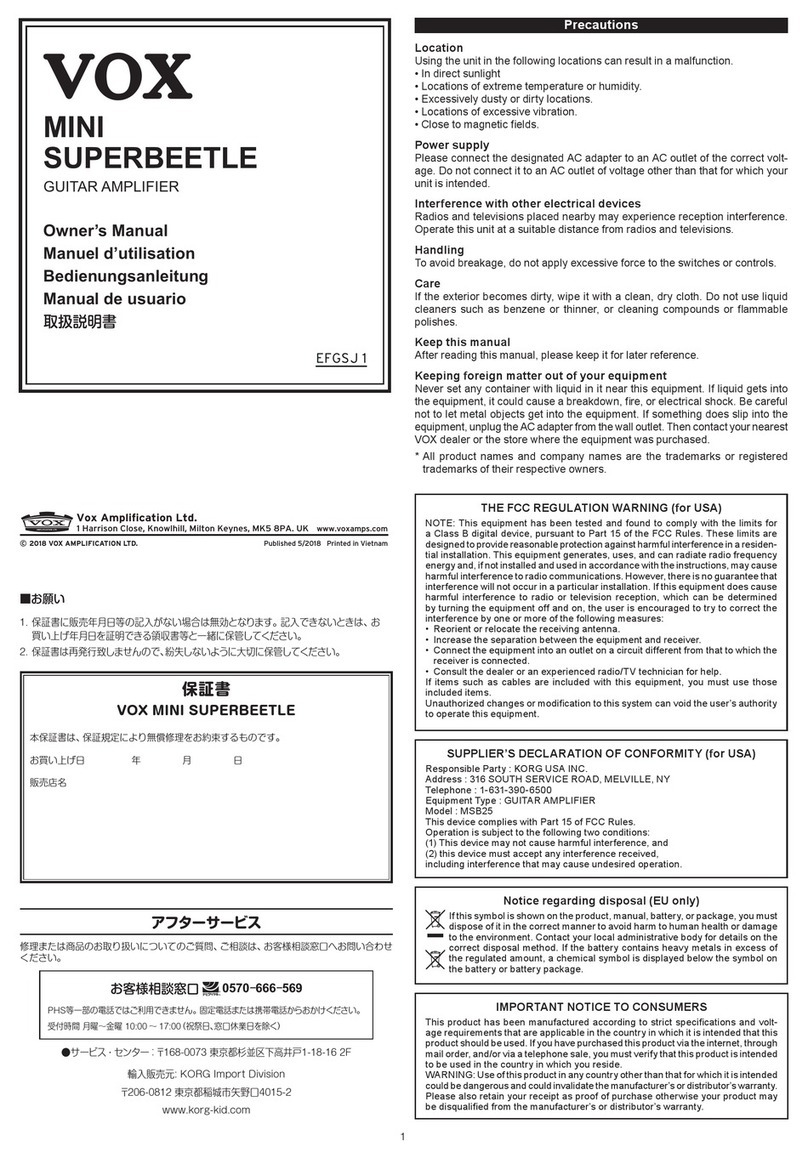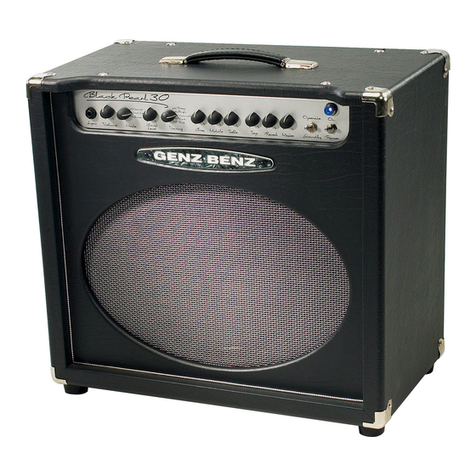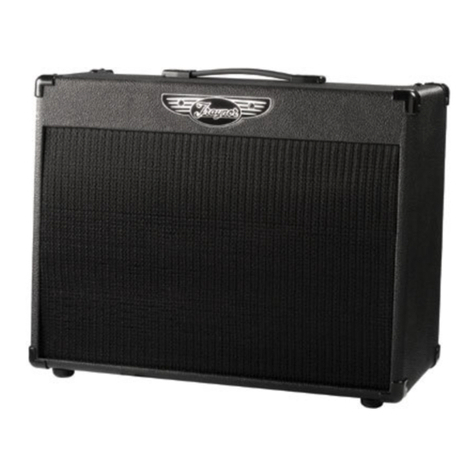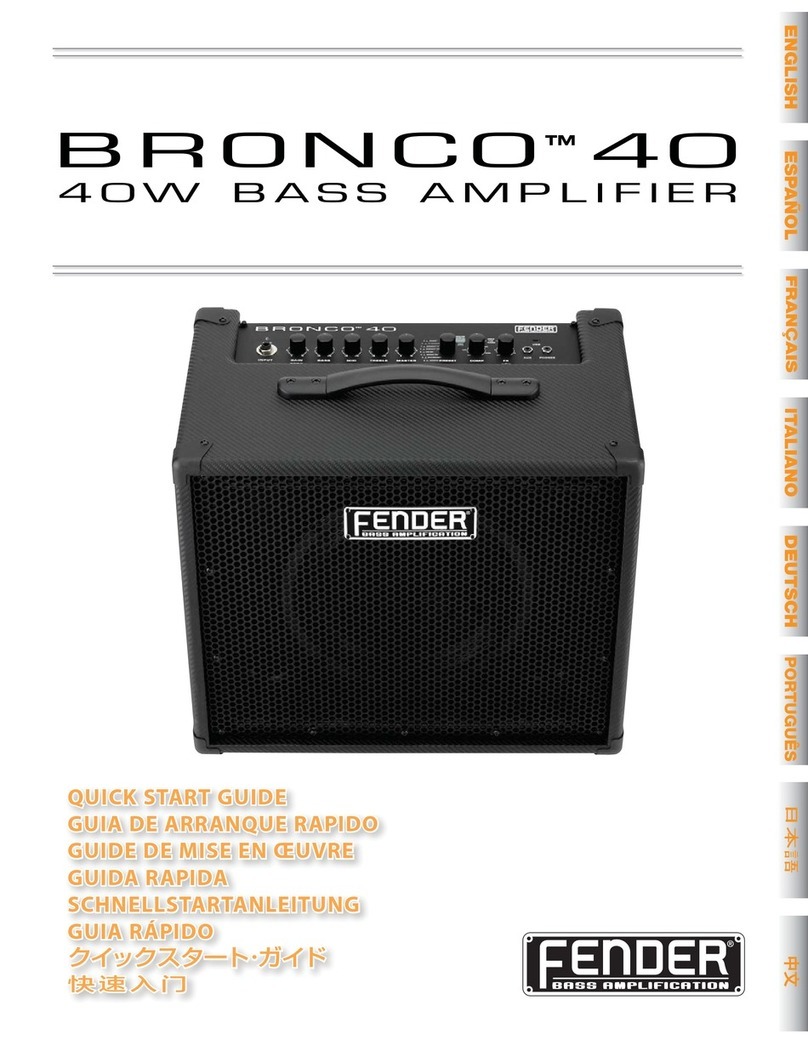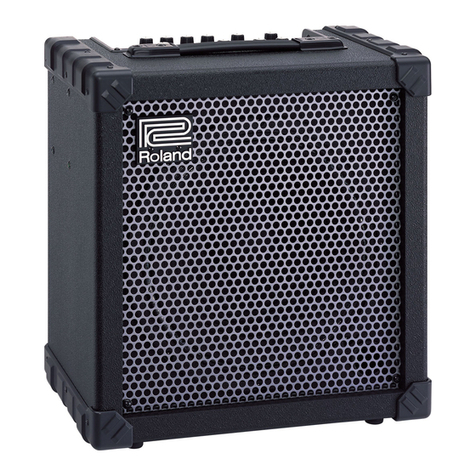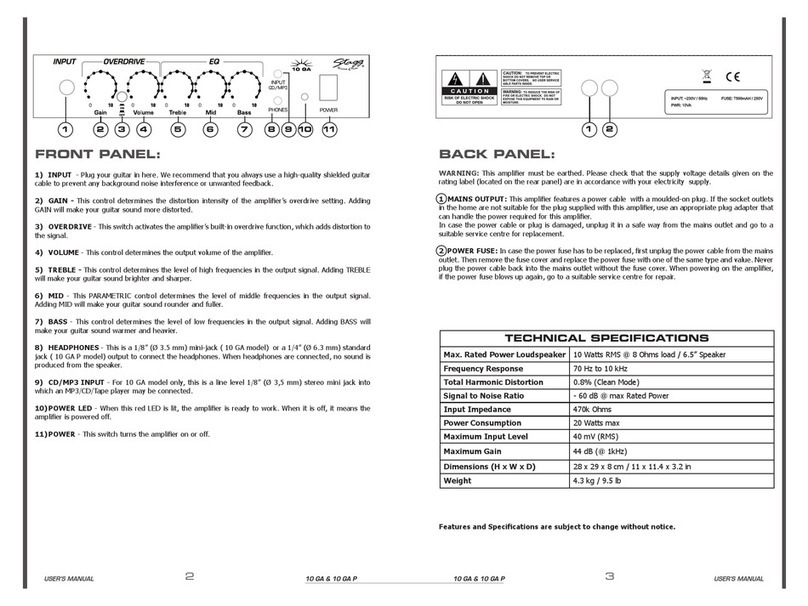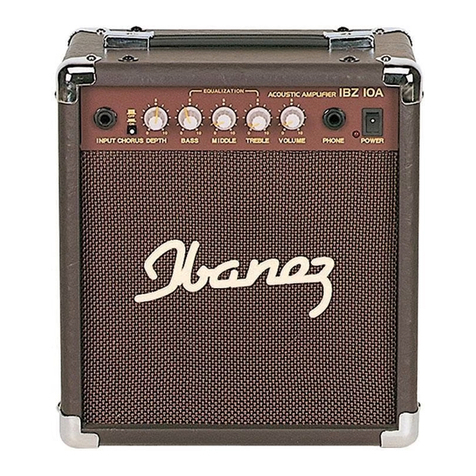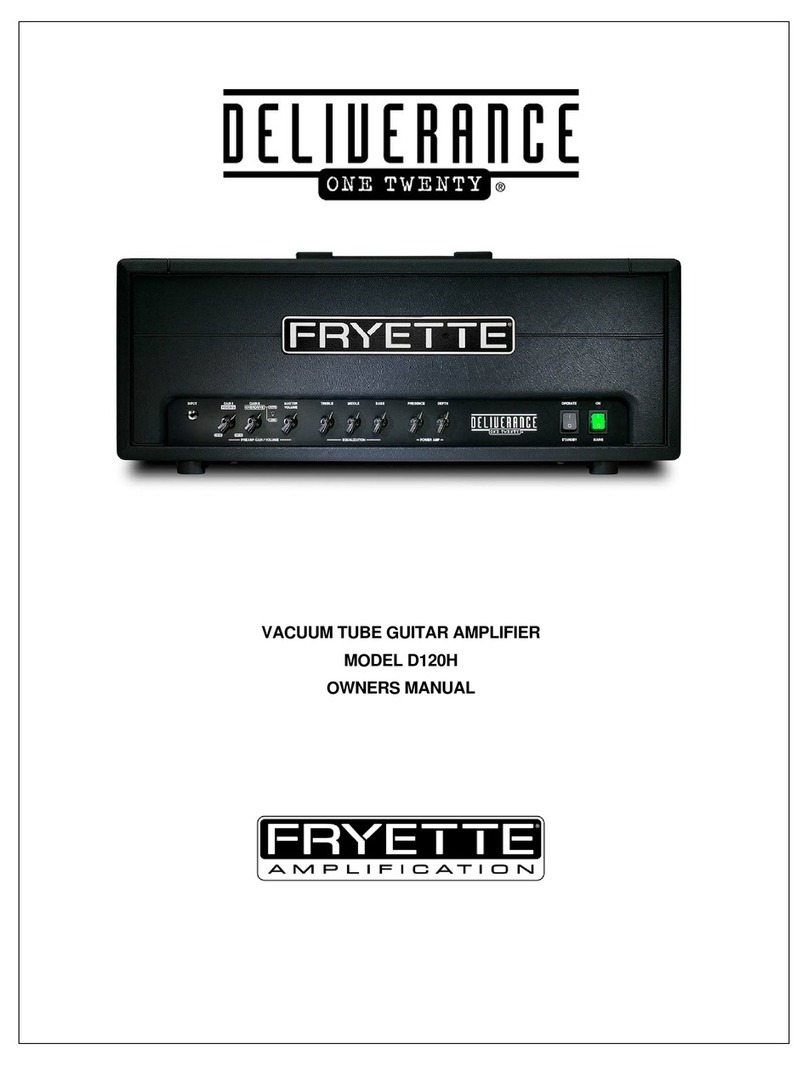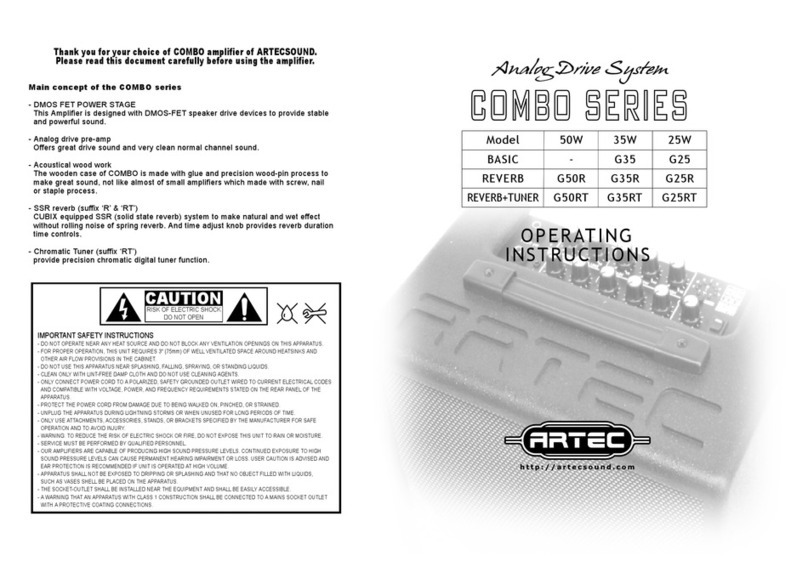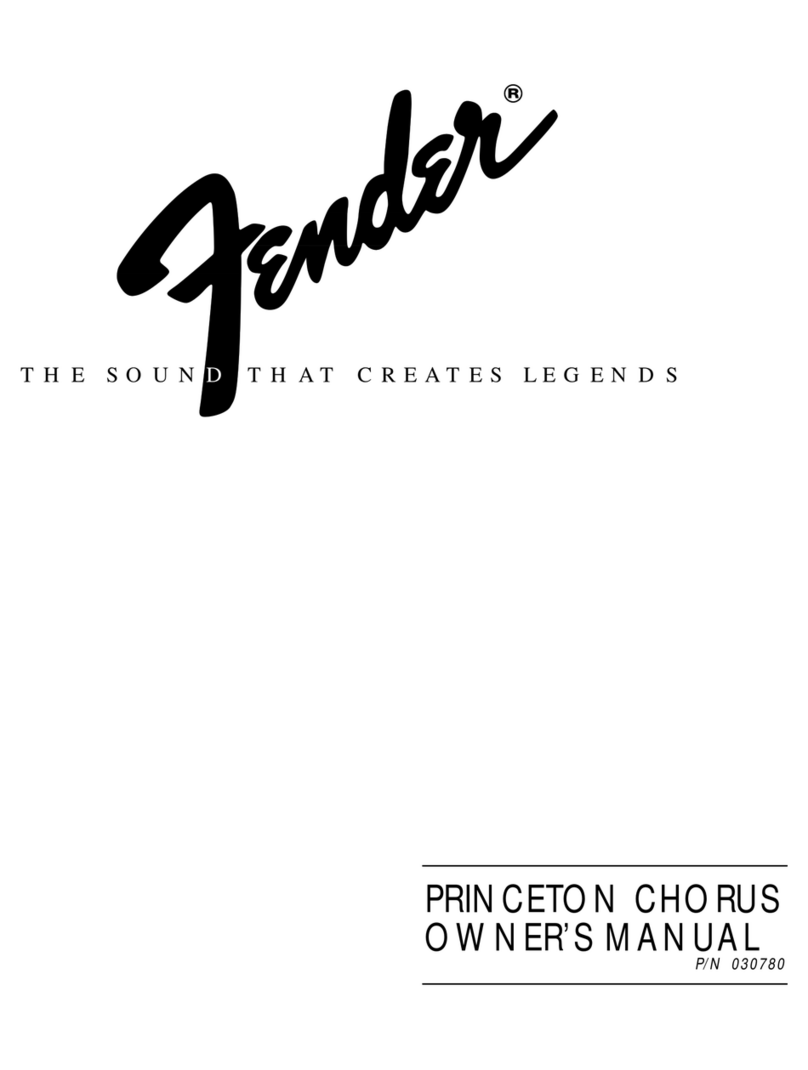tech21 NYC User manual

T: 973-777-6996
W: www.tech21nyc.com
© 2005
DESIGNED AND MANUFACTURED IN THE U.S.A.
OWNER’S MANUAL
POWER REQUIREMENTS
*Operable with phantom power supply, minimum 24V DC regulated, however, 48V DC regulated is
recommended in order to illuminate LED.
*Utilizes standard 9V alkaline battery (not included).To install, simply remove door cover. (NOTE:
The Input activates battery.To conserve energy, unplug when not in use.) Power Consumption:
approx. 5mA.
*USE DC POWER SUPPLY ONLY! Failure to do so may damage the
unit and void warranty. DC Power Supply Specifications:
-9V DC regulated or unregulated, 100mA minimum;
-2.1mm female plug, center negative (-).
Optional factory power supply is available:Tech 21 Model #DC2.
WARNINGS:
*Attempting to repair unit is not recommended and may void warranty.
*Missing or altered serial numbers automatically void warranty. For your own protection: be sure
serial number labels on the unit’s back plate and exterior box are intact, and return your warranty
registration card.
ONEYEAR LIMITED WARRANTY. PROOF OF PURCHASE REQUIRED. Manufacturer
warrants unit to be free from defects in materials and workmanship for one (1) year from date of
purchase to the original purchaser and is not transferable.Warranty does not include damage result-
ing from accident, misuse, abuse, alteration, or incorrect current or voltage. If unit becomes defective
within warranty period,Tech 21 will elect to repair or replace it at no cost.After expiration,Tech 21
will repair unit for a fee.
ALL REPAIRS for residents of U.S. and Canada: Call Tech 21 for Return Authorization Number.
Manufacturer will not accept packages without prior authorization, pre-paid freight (UPS preferred)
and proper insurance.
FOR PERSONAL ASSISTANCE & SERVICE:
Contact Tech 21 weekdays from 9:00 AM to 5:00 PM, EST.

TECH 21, THE COMPANY
Tech 21, Inc., was formed by a guitarist possessing the unusual combination
of a trained ear and electronics expertise. In 1989, B.Andrew Barta incorporated Tech 21 and made his
invention commercially available to players and studios around the world. His highly-acclaimed
SansAmp™ pioneered Tube Amplifier Emulation in professional applications for recording direct and
performing live, and created an entirely new category of signal processing.There have since been many
entries into this niche, yet SansAmp continues to maintain its reputation as the industry standard.
In addition to a full line of SansAmp models,Tech 21 also offers effect pedals; a battery operable MIDI
footcontroller, the MIDI Mouse; as well as “traditional” style amplifiers for guitar and bass. Each product
is thoughtfully and respectfully designed by B.Andrew Barta himself with the player in mind.
Tech 21’s goal is to provide you with flexible, versatile tools to cultivate, control, refine and redefine
your own individual sound.We take great pride in delivering consistent quality sound, studio to studio,
club to club, arena to arena.
PRODUCT OVERVIEW
SansAmp Programmable Bass Driver DI (PBDR) combines the warmth of a 100% analog signal path
with the convenience of digital programmability in a super simple, player-friendly stomp box format.
Our proprietary technology captures the rich, natural harmonics and sweet overdrive characteristics
inherent to tube amplifiers, and does so even at low volume. SansAmp PBDR delivers the same dynam-
ics, responsiveness, and sound quality of massive pro stage rigs in a portable, programmable, 3-channel
pedal.
The ease of operation allows you to make changes on the fly, at the gig, even during your performance
--without having to take this manual with you.There are no complex formulas or numerical calculations
to learn, so SansAmp PBDR won’t get in the way of your creative flow.
Independent footswitches put your three favorite tones right at your feet, from warm vintage to Sumo-
sized overdrive. Custom actuators provide a smooth transition between channels for instantaneous
switching, so you can dance to the music instead of your gear. As with each SansAmp model, the con-
trols are designed to give you the flexibility to obtain your desired sound, be it at home, in a local
bistro or on a world tour.
APPLICATIONS
WITH BASS AMP
Run the 1/4” output of SansAmp PBDR directly into the input of the power amp input, a.k.a.“effects
return” (if applicable), of an amp.This will bypass the tone coloring section of the pre-amp and will
defeat the amp’s master volume.
NOTE: BE SURE the BASS GUITAR VOLUME is OFF --BEFORE you turn on the amp.
Then slowly increase the volume of the bass. If it’s too loud overall, check that the 1/4” Out Boost switch
is disengaged (up) and then edit your presets accordingly. If it doesn’t get loud enough for you, engage
(depress) the 1/4” Out Boost switch to add 10dB.
Or, you can run SansAmp PBDR into the front input of an amp. Be sure to keep the Level of SansAmp
close to unity gain, so as not to overload the amp’s input, which could result in undesirable distortion.
Tips for setting up your amp when using front input:
1. Plug into low gain channel or input.
2. Turn off Bright switch.
3. Turn presence control (if applicable) to 12 o’clock or below.
4. Set tone controls as flat as possible.
TO DRIVE A POWER AMP
Run the output of SansAmp PBDR into the input of a power amp with an input sensitivity of -10dB to
0dB.Then use the master volume control of the power amp to adjust your stage volume.
TO RECORD DIRECT
You can plug directly into the input of a mixer/recorder and use the on-board sounds of SansAmp
PBDR. Bear in mind, full-range systems yield a wide frequency response.Therefore, you may need to
adjust the EQ settings of SansAmp PBDR to compensate.
THE INS AND OUTS
Follow Standard Audio Procedure:
TURN (SansAmp PBDR) ON FIRST. TURN OFF LAST. To avoid unwanted and potentially speaker-dam-
aging “pops” when connecting or disconnecting any equipment, ALWAYS MUTE mixing board and/or turn
down amp volume before plugging or unplugging!
WARNING:
DO NOT run the speaker output of any amp directly into SansAmp PBDR. Severe damage to
the amp and/or SansAmp PBDR may result.
1/4” INPUT: 1 megOhm, instrument level.Also switches battery power on/off.To avoid battery drain,
unplug when unit is not in use.
BALANCED XLR OUTPUT: Balanced 600-Ohm low Z output. Sends effected or bypassed signal to
mixing console/recorder.
XLR Out Pad Switch: -20dB pad to match the output to
equipment with different input level requirements. In the line level
(up) position, the output is 0dB. In the instrument level (down)
position, the output is -20dB.
1/4” OUTPUT: Unbalanced 1KOhm low Z output. Sends effected or bypassed signal to amp rig or
power amp.
1/4” Out Boost Switch: +10dB boost to match the output to
equipment with different input level requirements. In the instrument
level (up) position, the nominal output is -10dB. In the line level
(down) position, the output is 0dB.
PHANTOM POWER
Allows you to “tap into” the power of a suitably equipped mixer, which, today, most are.As the 3-conductor
XLR sends the audio signal to the input of a mixer, the mixer sends voltage back to the unit via the same 3
wires, eliminating the need for an external power supply. Consult your mixer’s owner’s manual for set-up
instructions. For live and studio use, let the engineer know your SansAmp Bass Driver DI is phantom power
operable.
PHANTOM & GROUND CONNECT SWITCH: When engaged (depressed), the ground con-
nects and unit will accept phantom power through the XLR Output. Disengaged (up), the ground of your stage
system and other interconnected gear is lifted/isolated from the ground of the mixing console.
With a mixer only: If you are plugging your bass into the Bass Driver and taking the XLR Output to a
mixer --and do not have any other grounded equipment connected in the setup-- you will have to
engage (depress) the switch to connect the ground and activate the phantom power.
With a mixer and bass amp: If you are going to the mixer via the XLR and using the 1/4” Output to feed
a bass amp (with its own AC ground), you should set the switch in the up position for “Ground Lift” mode. If
you experience hum and/or buzz with the switch in either position, there is probably a problem with the AC
outlets you are plugging into.
NOTE: If using vintage equipment without proper grounds, take extra care connecting it to modern
grounded equipment.The inadequacies of the ground in vintage gear could result in damaging anything it is
connected to.
NOTE: While operating under phantom power, we recommend keeping a 9V alkaline battery installed at all
times to avoid the previously mentioned “pops” when lifting the ground (see above).

SIGNAL LEVEL TO INPUT
SansAmp PBDR is designed to accommodate instrument level signals to the Input, such as the output of
a bass, the output of distortion pedals, etc. Signal level to Input should be close to that of a standard
electric guitar (approx. -10dB / 250mV). NOTE: Hot pickups will increase the gain structure of
SansAmp PBDR.
GUIDE TO CONTROLS
PRESENCE: brings out the upper harmonic content and attack. For a smoother high end and for
clean settings, decrease to taste.
DRIVE: adjusts the overall amount of gain and overdrive, similar to when the output section of a tube
amp is being pushed.
BASS & TREBLE: Unlike passive controls that only cut, these active tone controls cut or boost
±
12dB from unity gain (12 o’clock).This powerful EQ section effectively reduces the need for a fixed
frequency mid control and enables you to achieve an extensive variety of curves --including a “mid-cut”
as well as a “mid-boost.”
Adjusting Mid-Range Content: The mid-range level is preset. Boosting Bass and Treble yields a
“mid-cut” (at 750 Hz) where the relative mid-range level is lower than the Bass and Treble frequency
levels. Cutting Bass and Treble yields a “mid-boost” (at 750 Hz) where the relative mid-range level is
higher than the Bass and Treble frequency levels. NOTE: The overall output level will change relative to
your EQ settings. Simply adjust the Level control accordingly.
BLEND allows you to blend the direct instrument signal with SansAmp Tube Amplifier Emulation cir-
cuitry. In most cases, you will probably have this set at maximum (100% SansAmp). For certain applica-
tions, however, such as an ultra-transparent sound or for use with piezo pickup-equipped instruments,
you may want to blend-in some of the direct signal to achieve your desired sound.While the SansAmp
Tube Amplifier Emulation circuitry is bypassed when Blend is at minimum, the Bass, Treble and Level con-
trols remain active.
LEVEL adjusts the output level of both the 1/4” and XLR outputs.
PROGRAMMING THE CHANNELS
HOW TO SAVE A PROGRAM
Select a channel where you want the setting located. Set the knob controls to taste. Double click on
that channel’s footswitch and it’s saved. It’s that easy.
HOW TO FIND A PRESET
This is useful when you want to know the position of each knob’s setting in the memory of a channel.
When you turn a knob from its stored position, it “unlocks” and the channel indicator LED will blink.
The slower the blink, the farther away you are from the preset point.The faster the blink, the closer
you are.At the preset point, the LED stops blinking and remains on.
LAZY POT™
Another Tech 21 first, is the development of the Lazy Pot.This is a unique safety feature engineered for
the Drive and Level controls.When you “unlock” the EQ settings, for instance, they will “jump” to the
new setting of the knob position. For the Drive and Level controls, however, this could result in you
jumping out of your skin if they are at a high setting.With the Lazy Pot, there’s a slow, gradual increase
to the new setting position giving you time to turn it down.This will only happen when you initially
unlock a preset. Once unlocked, the pot will react according to how you reposition it.
BYPASS
SansAmp PBDR can go into bypass mode from any of the three channels.Whichever channel you’re
already in, hit that channel’s footswitch once and you’ll be in bypass mode.
GLOBAL RESET
If you want to reset your unit back to factory specifications, you can simply reprogram each of the first
three Sample Settings: (1) Fat Tube (2) Flip Top (3) Distorted Bass
Or, you can perform the following procedure: Hold down the footswitches for Channels 1 and 3 while
simultaneously applying power (either plugging in an adapter or, if a battery is installed, plugging in your
guitar cable).Then release the switches.
SPEAKER SIMULATION
Built-in speaker simulation is an integral part of the SansAmp circuitry. It shapes the sound to match the par-
ticular cabinet of the amp type selected. It is specifically designed for a smooth, even response as would be
achieved by a multiply-miked cabinet, without the peaks, valleys, and notches associated with single miking.
Therefore, it will not adversely affect or interfere with the sound of your own speaker cabinet.
PLACEMENT ORDER OF OTHER EFFECTS
One of the key attributes of any SansAmp is its responsiveness to the dynamics and nuances of your playing
technique. In most cases, your bass should be plugged directly into the SansAmp.We suggest experimenting
to find the order that’s best for you.As a general guide, we recommend:
Place the following effects BEFORE SansAmp PBDR:
Wah-Wah, Pre-Amp, Compressor, Fuzz Box, Envelope Follower.
Place the following effects AFTER SansAmp PBDR:
Chorus, Delay, EQ, Pitch Shifter, Reverb.
NOTE: Low quality digital effects placed after SansAmp PBDR may compromise your signal and degrade the
sound.
NOTEWORTHY NOTES
1) Do not A/B (compare) SansAmp PBDR in line with a digital product. When linked in series
with a digital pre-amp/processor, the A/D to D/A conversion will impact the unit’s sound. For an accurate
comparison, run them parallel (separately) and manually plug in and out of each.
2) SansAmp PBDR is very responsive. Our controls are unusually sensitive and powerful.You need not
set everything at max to get maximum results. For instance, to brighten your sound, rather than automatically
boosting Treble all the way up, try cutting back on the Bass first.
The tone controls also help compensate for the EQ curves found in bass amps.To find the best settings for
interacting with your amp, start with the tone controls at 12 o’clock and cut or boost as necessary. Be aware
that amplifiers vary greatly and some may require you to use radical EQ settings on the SansAmp PBDR to
achieve your desired sound.You need not be discouraged or suspect something is wrong with the unit. If
you’ve got your sound, you’ve simply found the right balance for your particular amp.
3) The noise level of SansAmp PBDR is exceptionally low. However, it may amplify noise emanating
from the input source.To minimize noise going into SansAmp PBDR, we recommend active electronic instru-
ments have the volume set at unity gain/maximum and tone controls positioned flat. If you need to boost, do
so slowly and sparingly.
Also check for pickup interference by moving your guitar or turning the volume off. Be aware single coil pick-
ups are more likely to generate noise.
4) Preset and Sample Setting levels and tones will vary depending on the bass, amp and cabinet you
use.They were determined using a “typical” bass and cabinet, and are provided as a starting point. So, some
adjustments may be necessary, particularly to the Level control. For instance, if you have a high output bass, a
clean setting will be louder than a distorted one. Conversely, a low output bass will require a higher level for
a clean setting. If you have a big cabinet, the Fat Tube setting will be louder.With a smaller cabinet, the Flip
Top setting will be louder.
5) REMEMBERTHIS WARNING: DO NOT run the speaker output of any amp directly into
SansAmp PBDR. Severe damage to the amp and/or SansAmp PBDR may result.


This manual suits for next models
1
Other tech21 Musical Instrument Amplifier manuals

tech21
tech21 BOOST OVER DRIVE User manual
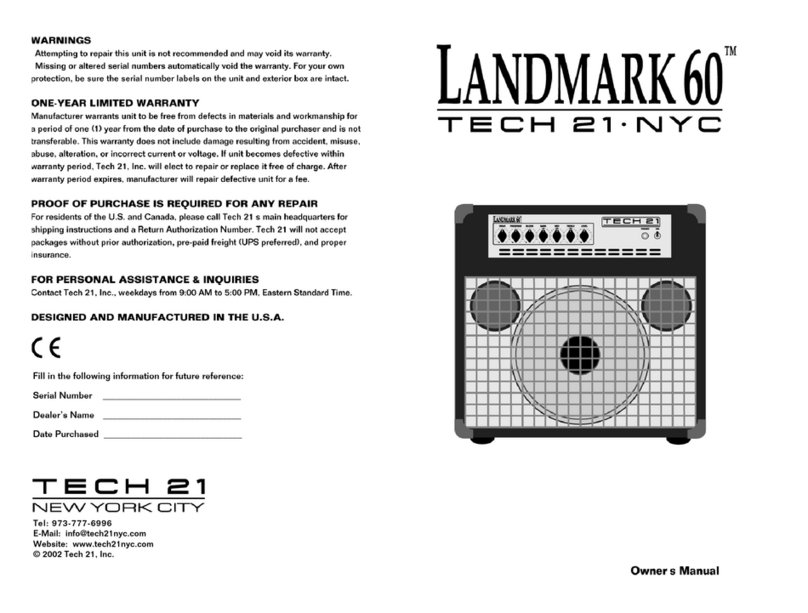
tech21
tech21 Landmark 60 User manual
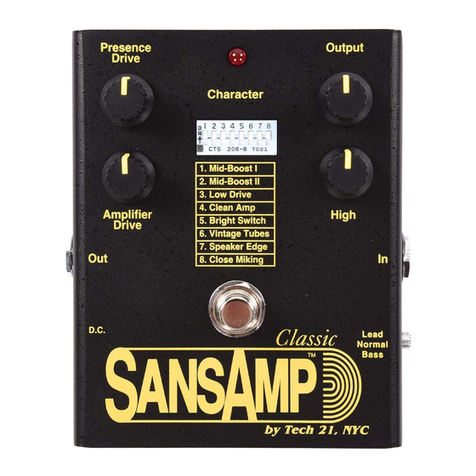
tech21
tech21 SansAmp Classic User manual

tech21
tech21 Landmark 60 User manual
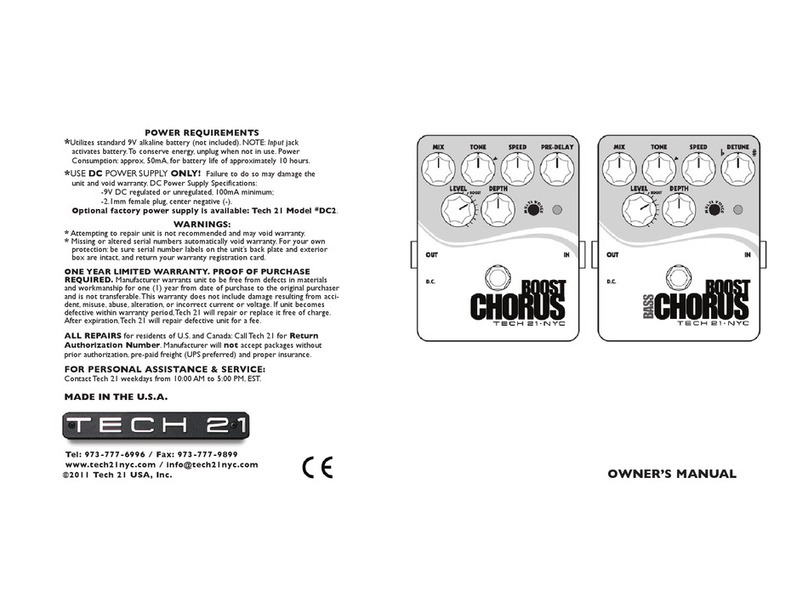
tech21
tech21 BOOST CHORUS User manual
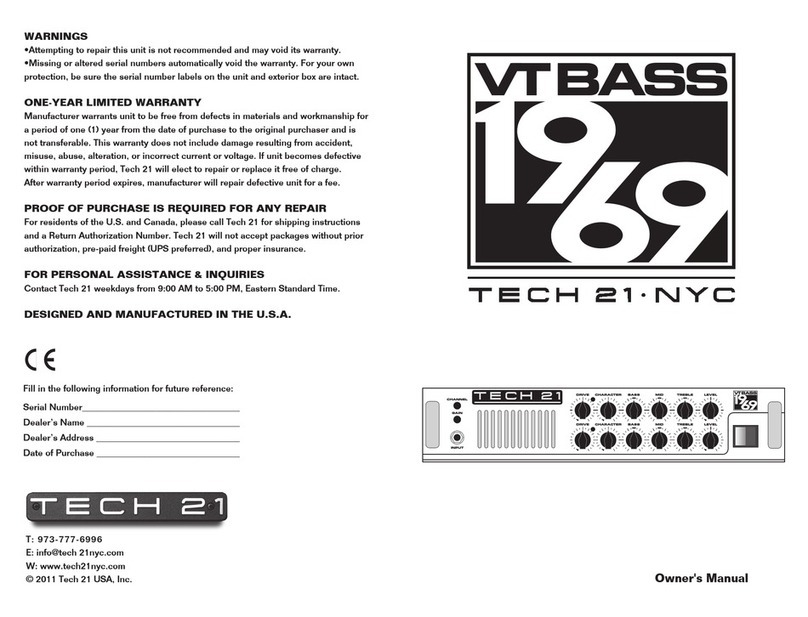
tech21
tech21 VT BASS 1969 User manual
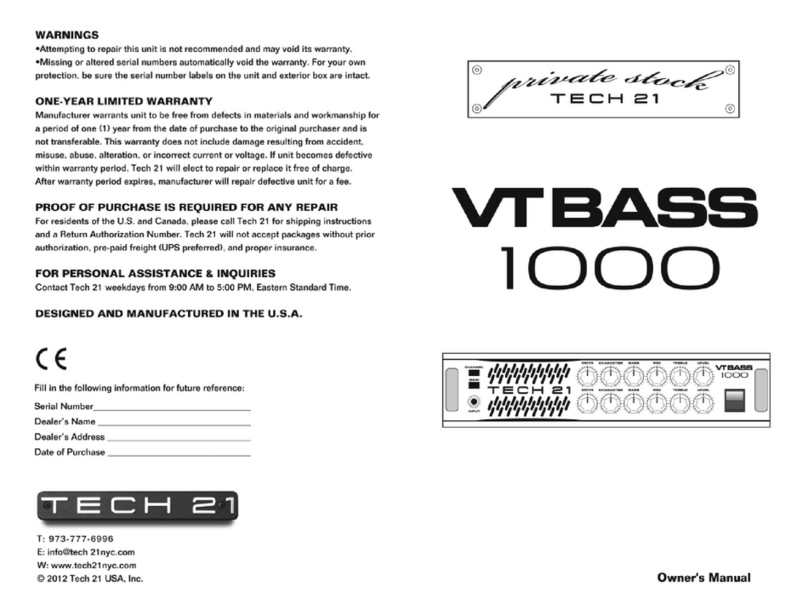
tech21
tech21 dUg Ultra Bass 1000 User manual
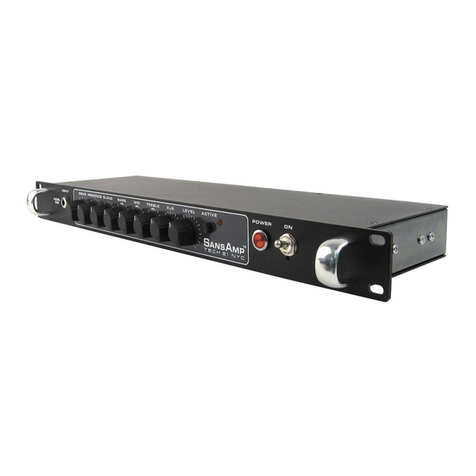
tech21
tech21 SansAmp RBI User manual

tech21
tech21 Power Engine Deuce Deluxe PE-200 User manual
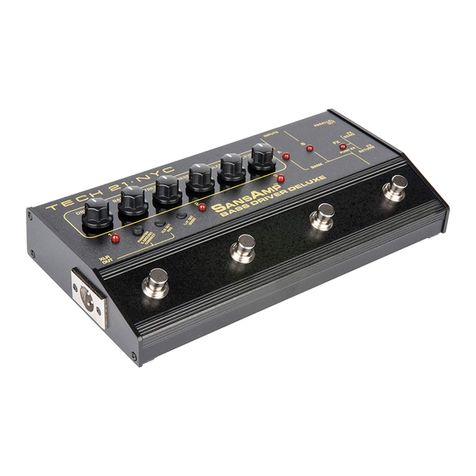
tech21
tech21 SansAmp BASS DRIVER DELUXE User manual
